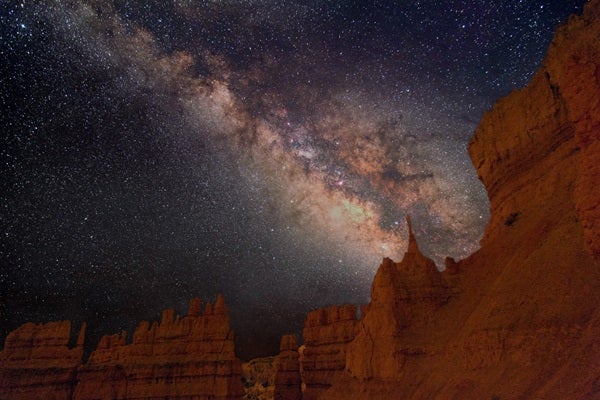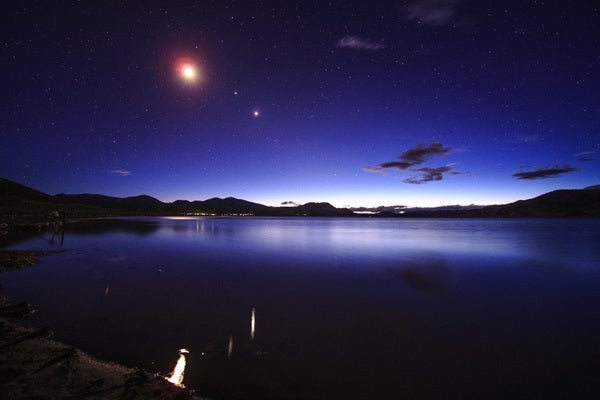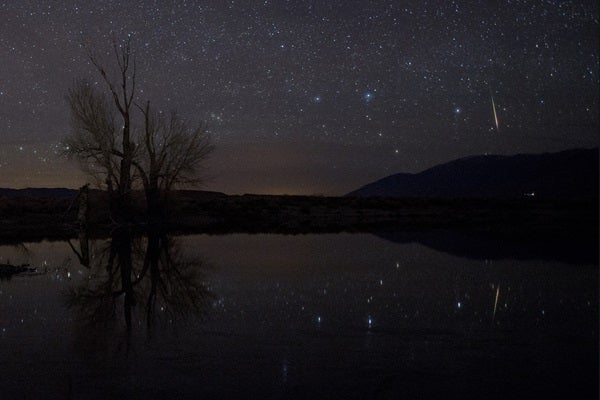New Moon occurs at 6:37 a.m. EDT. At its New phase, the Moon crosses the sky with the Sun and so remains hidden by our star. Because the Moon reaches perigee, the closest point in its orbit around Earth, only five hours later (at 11:53 a.m. EDT), residents in coastal areas can expect higher than normal tides for the next few days. At perigee, the center of the Moon lies 221,939 miles (357,176 kilometers) from Earth’s center.
Saturday, August 31
Evenings this week are great times to explore the constellation Sagittarius the Archer. This star group lies due south and at peak altitude around 9 p.m. local daylight time, just as the last vestiges of twilight fade away. The brightest stars within the constellation form the shape of a teapot — a distinctive asterism once you’ve found it. The central regions of the Milky Way pass through Sagittarius, so it’s always worth exploring the area through binoculars or a telescope.
Sunday, September 1
The Aurigid meteor shower peaks this morning, with the best views coming when the radiant (which lies in the constellation Auriga) climbs high before dawn. Although this minor shower typically produces only 6 meteors per hour under optimal conditions, it occasionally performs much better. Rates six times higher than normal occurred in 1935, 1986, and 1994, and viewers recorded up to 130 meteors per hour for a brief stretch in 2007. No one knows when the shower will burst out again, but conditions should be nearly perfect this year with the Moon absent from the morning sky.
Monday, September 2
Distant Neptune reaches opposition and peak visibility next week, but the view now is essentially the same. The ice giant planet rises during evening twilight and climbs halfway to the zenith in the southern sky by 1:30 a.m. local daylight time. Finding Neptune through a telescope doesn’t get much easier than it does this week — the magnitude 7.8 world lies in the same low-power field as the magnitude 4.2 star Phi (φ) Aquarii. Tonight, the planet stands just 6′ east-northeast of the star, and the gap narrows with each passing day. They will appear closest the night of September 5/6. You’ll need binoculars to spy Neptune and a telescope to see its 2.4″-diameter disk.
Mars reaches solar conjunction at 7 a.m. EDT, when it lies on the far side of the Sun from our perspective. The Red Planet will remain hidden in our star’s glare until it emerges into morning twilight in late October.
Tuesday, September 3
Observers of the outer solar system can get good views of Uranus during the late evening hours. The ice giant planet rises before 10 p.m. local daylight time and climbs 25° high in the east by midnight. It reaches its peak about 60° above the southern horizon shortly before the start of morning twilight. Uranus glows at magnitude 5.7 against the backdrop of southern Aries the Ram. Use binoculars to find the planet 2.3° south-southeast of the similarly bright star 19 Arietis. A telescope reveals Uranus’ blue-green disk, which spans 3.7″.
Mercury reaches superior conjunction at 10 p.m. EDT. This means the innermost planet lies on the opposite side of the Sun from Earth and remains hidden in our star’s glare. It will return to view just after sunset at the end of the month.
Wednesday, September 4
Jupiter continues to dominate the evening sky from its perch in southern Ophiuchus the Serpent-bearer. The giant planet shines at magnitude –2.2 and stands nearly 25° high in the south-southwest as twilight fades to darkness. When viewed through a telescope, the planet shows a 39″-diameter disk and striking details in its massive atmosphere. If you look carefully, you also might notice a black dot silhouetted against the cloud tops. Jupiter’s innermost major moon, volcanically active Io, transits the gas giant’s disk this evening. Io first touches the planet’s limb at 8:04 p.m. EDT, and its dark shadow follows at 9:21 p.m. Both moon and shadow take about 130 minutes to cross the jovian disk.
First Quarter Moon arrives at 11:10 p.m. EDT. Our satellite rises in the southeast around 2 p.m. local daylight time, but it doesn’t become prominent until the Sun sets around 7:30 p.m. (The Moon then lies in the southern sky about one-third of the way to the zenith.) After darkness falls, the Moon’s half-lit orb appears in southern Ophiuchus just 4° to the right of brilliant Jupiter and 7° above the 1st-magnitude star Antares in neighboring Scorpius.
Tonight marks the closest approach of Neptune to 4th-magnitude Phi Aquarii. At 11 p.m. EDT, the planet lies 42″ east of the star, and the separation tightens by about 4″ with each passing hour. They come closest — 13″ apart — shortly after daybreak on the 6th. The two make a lovely contrast through a telescope all night, with Phi a ruddy point of light and Neptune showing a blue-gray disk.
Friday, September 6
The variable star Algol in Perseus reaches minimum brightness at 2:05 a.m. EDT tomorrow morning. Observers on the East Coast who start watching around midevening can see the star’s brightness diminish by 70 percent over the course of about five hours. Those in western North America will see Algol brighten noticeably from late evening until dawn starts to paint the sky, when the star passes nearly overhead. This eclipsing binary system runs through a cycle from minimum (magnitude 3.4) to maximum (magnitude 2.1) and back every 2.87 days.
Saturday, September 7
The waxing gibbous Moon points the way to Saturn this evening. The dazzling Moon lies due south as darkness falls while the magnitude 0.4 planet appears 9° to its left. They inch slightly closer by the time they reach the western horizon after midnight. They are in conjunction with each other after dawn on the 8th, and by evening twilight tomorrow, the planet stands 3° to the Moon’s right. It’s worth checking out Saturn through a telescope, particularly earlier in the week when it’s farther from the Moon’s glare. Even the smallest scope shows the planet’s 17″-diameter disk and its magnificent rings, which span 40″ and tilt 25° to our line of sight.
The constellations Ursa Major the Great Bear and Cassiopeia the Queen lie on opposite sides of the North Celestial Pole, so they appear to pivot around the North Star (Polaris) throughout the course of the night and the year. In late August and early September, these two constellations appear equally high as darkness falls. You can find Ursa Major and its prominent asterism, the Big Dipper, about 30° above the northwestern horizon. Cassiopeia’s familiar W shape, which currently lies on its side, appears the same height above the northeastern horizon. As the night progresses, Cassiopeia climbs above Polaris while the Big Dipper swings below.












